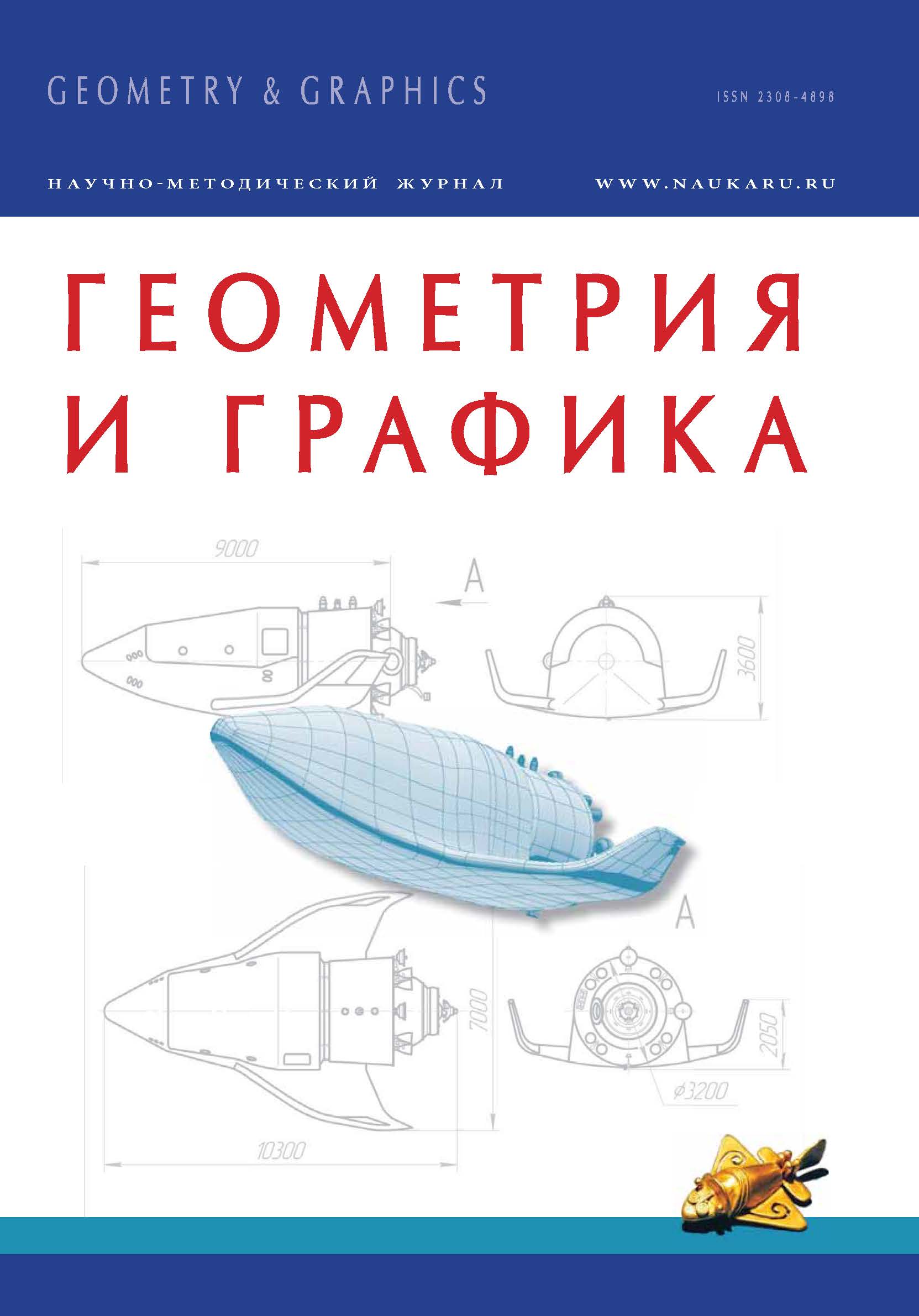Chelyabinsk, Chelyabinsk, Russian Federation
The fundamental issue of constructing a nine-point quadric was frequently discussed by mathematicians in the 19th century. They failed to find a simple linear geometric dependence that would join ten points of a quadric (similar to Pascal's theorem, which joins six points of a conic section). Nevertheless, they found different algorithms for a geometrically accurate construction (using straightedge and compass or even using straightedge alone) of any number of points of a quadric that passes through nine given points. While the algorithms are quite complex, they can be implemented only with the help of computer graphics. The paper proposes a simplified computer-based realization of J.H. Engel’s well-known algorithm, which makes it possible to define the ninepoint quadric metric. The proposed graphics algorithm can be considered an alternative to the algebraic solution of the stated problem. The article discusses two well-known graphical algorithms for constructing a quadric (the Rohn — Papperitz algorithm and the J.H. Engel algorithm) and proposes a simplified version of the J.H. algorithm. For its constructive implementation using computer graphics. All algorithms allow you to determine the set of points and the set of flat sections of the surface of the second order, given by nine points. The Rohn — Papperitz algorithm, based on the spatial configuration of Desargues, is best suited for its implementation on an axonometric drawing using 3D computer graphics. Algorithm J.H. Engel allows you to solve a problem on the plane. The proposed simplified constructive version of the algorithm J.H. Engel is supplemented with an algorithm for constructing the principal axes and symmetry planes of a quadric, given by nine points. The construction cannot be performed with a compass and a ruler, since this task reduces to finding the intersection points of two second-order curves with one known general point (third degree task). For its constructive solution, a computer program is used that performs the drawing of a second order curve defined by an arbitrarily specified set of five points and tangents (both real and imaginary). The proposed graphic algorithm can be considered as an alternative to the algebraic solution of the problem.
zehnter Punkt Problem, biquadratic curves, pencils of conic sections, pencils of quadrics, spatial configuration of Desargues, Pascal-Schema
1. Boykov A.A. K voprosu o metodike ispol'zovaniya algoritmov pri reshenii zadach nachertatel'noj geometrii [On the issue of the use of algorithms for solving problems of descriptive geometry]. Geometriya i grafika [Geometry and graphics]. 2018, V. 6, I. 3, pp. 56-68 (in Russian). DOIhttps://doi.org/10.12737/issn.2308-4898
2. Vol'berg O.A. Osnovnye idei proektivnoy geometrii [The Basic Ideas of Projective Geometry]. Moscow-Leningrad, Gosudarstvennoe uchebno-pedagogicheskoe izdatel'stvo Publ., 1949, 188 p. (in Russian).
3. Voloshinov D.V. Vizual'no-graficheskoe proektirovanie edinoj konstruktivnoj modeli dlya resheniya analogov zadachi Apolloniya s uchetom mnimyh geometricheskih obrazov [Visual graphic design of a unified constructive model for solving analogs of the Apollonian problem taking into account imaginary geometric images]. Geometriya i grafika [Geometry and graphics]. 2018, V. 6, I. 2, pp. 23-46. (in Russian). DOIhttps://doi.org/10.12737/issn.2308-4898
4. Voloshinov D.V. Edinyj konstruktivnyj algoritm postroeniya fokusov krivyh vtorogo poryadka [Unified constructive algorithm for constructing focuses of second order curves]. Geometriya i grafika [Geometry and graphics]. 2018, V. 6, I. 2, pp. 47-54. (in Russian). DOIhttps://doi.org/10.12737/issn.2308-4898
5. Hirsh A.G., Korotkiy V.A. Graficheskie algoritmy rekonstrukcii krivoj vtorogo poryadka, zadannoj mnimymi ehlementami [Graphic algorithms for the reconstruction of the second order curve given by imaginary elements]. Geometriya i grafika [Geometry and graphics]. 2016, V. 4, I. 4, pp. 19-30 (in Russian). DOIhttps://doi.org/10.12737/22840
6. Glagolev N.A. Proektivnaya geometriya [Projective Geometry]. Moscow, Vysshaya Shkola Publ., 1963, 344 p. (in Russian).
7. Korotkiy V.A. Sinteticheskie algoritmy postroeniya krivoj vtorogo poryadka [Synthetic Algorithms for Constructing a Curve of the Second Order]. Vestnik komp'yuternykh i informatsionnykh tekhnologiy [Journal of computer and information technology]. 2014, I. 11, pp. 20-24. (in Russian). DOI:https://doi.org/10.14489/issn.1810-7206
8. Korotkiy V.A., L.I. Hmarova. Universal'nyj komp'yuternyj konikograf [Universal computer program for tracing conic sections]. Trudy 26-j Mezhdunarodnoj nauchnoj konferencii GraphiCon 2016 (19-23 sentyabrya 2016) [Proceedings of the 26th International Scientific Conference GraphiCon 2016]. Nizhnij Novgorod, NNGASU Publ., pp. 347-351. (in Russian).
9. V. Korotkiy: Construction of a Nine-Point Quadric Surface. Journal for Geometry and Graphics, Austria, Volume 22 (2018), No. 2, 183-193.
10. Korotkij V.A., Usmanova E.A. Krivye vtorogo poryadka na ehkrane komp'yutera [Second-order curves on a computer screen]. Geometriya i grafika [Geometry and graphics]. 2018, V. 6, I. 2, pp. 101-113. (in Russian). DOIhttps://doi.org/10.12737/issn.2308-4898
11. Korotkij V.A. Komp'yuternaya vizualizaciya krivoj vtorogo poryadka, prohodyashchej cherez mni-mye tochki i kasayushchejsya mnimyh pryamyh [Computer visualization of the second order curve passing through imaginary points and touching imaginary straight lines]. Nauchnaya vizualizaciya [Scientific visualization]. 2018, V. 10, I. 1, pp. 56-68. (in Russian).
12. Korotkiy V.A. Programma dlya EHVM «Postroenie krivoy vtorogo poryadka, prokhodyashchey cherez dannye tochki i kasayushchikhsya dannykh pryamykhi» [The Construction of the Curve of the Second Order Passing Through the Data Points and Data Concerning Direct]. Svid. o gosudarstvennoy registratsii programmy dlya EVM. no. 2011611961, 04.03.2011 [State Registration Certificate No. 2011611961 dated March 4, 2011].
13. Sal'kov N.A. Formirovanie poverhnostej pri kineticheskom otobrazhenii [Formation of surfaces during kinetic imaging]. Geometriya i grafika [Geometry and graphics]. 2018, V. 6, I. 1, pp. 20-33. (in Russian). DOIhttps://doi.org/10.12737/issn.2308-4898
14. M. Chasles: Aperçu historique sur l'origine et le développement des methods en Géométrie particuliérement de celles qui se rapportent à la Géométrie moderne. Paris 1875.
15. J.H. Engel: Konstruktionen zur Geometrie der Flächen zweiter Ordnung und der ebenen Kurven dritter Ordnung. Vierteljahrsschrift der Naturforschende Gesellschaft in Zürich, 299-337 (1889).
16. T. Reye: Die Geometrie der Lage. II. Theil. Leipzig, Baumgärtner′s Buchhandlung 1892.
17. K. Rohn, E. Papperitz: Lehrbuch der Darstellenden Geometrie. Band II, Leipzig 1896.
18. O. Staude: Flaechen 2. Ordnung und ihre Systeme und Durchdringungskurven. In Encyklopaedie der Mathematischen Wissenschaften, Band III, Geometrie, Teil 2, Hälfte 1, Teubner, Leipzig 1903.






